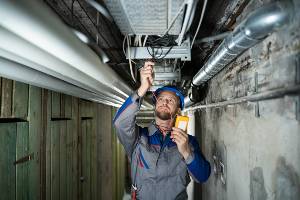Blog
What Are the Asbestos Exposure Risks for Electricians?
Posted on behalf of Peter T. Nicholl in Mesothelioma & Asbestos Published on June 16, 2022 and updated on June 17, 2022. There are a variety of risks involved in working as an electrician, such a electric shocks, falls and burn injuries. Electricians are also at risk for encountering asbestos, which could result in significant health problems in the future.
There are a variety of risks involved in working as an electrician, such a electric shocks, falls and burn injuries. Electricians are also at risk for encountering asbestos, which could result in significant health problems in the future.
Below, our experienced Maryland mesothelioma attorneys discuss common asbestos exposure risks for electricians. If you worked as an electrician and were exposed to asbestos, we may be able to help you seek compensation for your damages. We have secured millions on behalf of victims of asbestos exposure and are prepared to guide you through the legal process at no upfront cost.
Types of Electricians
There are generally three types of electricians:
Residential Electrician
They work in homes, apartment blocks and multi-family projects. They typically encounter light voltage.
Commercial Electrician
They work in medium-sized buildings, like businesses, schools and small factories.
Industrial Electrician
They work on much larger buildings. For example, they may install electric wiring and control components in factories, powerhouses and refineries.
There were also many specialized electricians working on car assembly lines, shipyards and aircraft manufacturing.
No matter where they worked, many were at risk for asbestos exposure, as this mineral was used in so many products across many industries for decades.
Some of the more at-risk occupations for electricians include:
- IT professionals
- Drafters
- Linemen
- Power station workers
- Construction workers
Dangerous Products Electricians May Encounter
Electricians may encounter asbestos-containing products when they perform maintenance on old equipment. For example, wire insulation may contain chrysotile asbestos. According to a 2018 toxicology study, asbestos wires used to be composed of between 75 percent and 85 percent chrysotile asbestos.
Old breaker boxes may also have felted asbestos insulation inside them.
When electricians cut or remove existing asbestos-containing wiring or other materials, asbestos dust could be released into the air. Electricians could easily breathe in these fibers once they get released into the air. Electricians used power tools, and these can grind materials, making materials more friable and more dangerous.
Some of the other asbestos-containing products electricians may encounter include:
- Arc chutes – These insulate and protect circuits and before the mid-1980s, these were made from plastic molding compounds that contained asbestos. If a high voltage spark ran through the arc chute, it could release dust and particles into the air.
- Heaters – Heat can cause asbestos-containing electrical wire to degrade over time. This makes it much easier for asbestos fibers to be released into the air.
- Electrical paper – This is also known as a flash guard, which was put into electrical boxes to help prevent fires. The problem is paper asbestos can easily break down and fibers can be released into the air.
- Generators – These used to contain asbestos-containing materials to help reduce the risk of overheating and resulting mechanical damage.
- Turbines – Asbestos was also used in turbines to reduce fire risk. Turbines are a common source of asbestos in power plants.
- Electrical shielding – Asbestos cement used to act as a shield between electrical components, like switches inside arc chutes.
- Cable wraps – These were often made from asbestos paper or asbestos plastic, as these were affordable. Unfortunately, these materials can degrade over time.
- Hot water heaters – The insulating blankets under the metal cover of old hot water tanks used to contain asbestos.
- Plastic panels – Electrical panels were often made from moldable plastics because these plastics could resist heat, moisture and electricity.
- Electric ducts/raceways – These were often filled with raceways to help prevent electric shorts and fires.
Construction sites and other places where electricians do their jobs could also have materials that are contaminated with asbestos. These materials may have nothing to do with an electrician’s work, but electricians encounter them when doing their jobs. For example, the following could contain asbestos:
- Flooring
- Tiles
- Roofing
- Siding
- Wall insulation
- Millboard
- Wallboard
- Vinyl flooring
- Plaster
- Popcorn ceilings
- HVAC systems
- Fireproofing material
- Sealants and adhesives
For many years, electricians even wore clothes that were made with asbestos to help reduce the risk of workers being electrocuted.
Companies That Made Products Used by Electricians
Many of the products used by electricians or products that electricians encountered when doing their jobs were made by some of the largest corporations, including:
- General Electric
- Westinghouse Electric
- Lincoln Electric
- Union Carbide
- Celotex Corporation
- C. E. Thurston & Sons
- Kaiser Gypsum Company, Inc.
- New England Insulation
- Kelley-Moore Paints
- Johns-Manville
- Georgia Pacific Corporation
- W.R. Grace
- Turner & Newall
- EaglePicher
- Ehret Magnesia
Are You an Asbestos Victim? Call for Legal Assistance
Our attorneys understand the challenges faced by asbestos victims and their families, as we have helped many people pursue compensation from the parties that allowed asbestos exposure to occur. We have extensive knowledge of these claims and are prepared to handle every step of the process on your behalf.
Our attorneys have secured hundreds of millions from asbestos trusts for large companies like Halliburton, Owens Corning, United States Gypsum and Kaiser Aluminum.
Have legal questions? Call Peter T. Nicholl Law Offices. 410-401-9979

